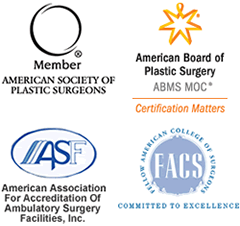About the Liposuction Procedure
Liposuction is the most popular cosmetic surgery procedure in the U.S.
In 2003 a total of 384,626 people underwent liposuction up from 176,863
in 1997 which represents a 117% increase. New techniques in liposuction
surgery have led to improved results with quicker recovery time.
Board Certified Plastic Surgeon, Douglas M. Senderoff, MD, FACS, performs
the majority of his liposuction procedures as an outpatient in his fully
accredited outpatient surgical facility located on Park Avenue South in
Manhattan, New York. The type of anesthesia most commonly used is a local
anesthesia solution combined with intravenous sedation. General anesthesia
is also used in selected patients. For small areas such as under the chin
local anesthesia alone without intravenous sedation can be used.
Candidates for Liposuction
The best candidates for liposuction are patients with localized fat deposits
that are resistant to diet and exercise. Liposuction can permanently eliminate
or reduce the size of these stubborn areas. Areas that are commonly treated
by liposuction include the hips, thighs, abdomen, flanks, back, chest, arms,
and chin. The amount of fat that is removed during the procedure depends
on several factors including the size of the fatty deposits, the quality
and availability of the fat, the patients health and the surgeons judgment.
Tumescent vs. Superwet Liposuction
Tumescent liposuction refers to the administration of large volumes of liposuction
solution containing lidocaine with epinephrine diluted in a liter of saline.
This solution is injected under the skin usually through a pump until the
skin becomes full and tense. With the tumescent technique no other anesthesia
is given. Superwet liposuction is similar except not as much solution is
injected. The amount of solution administered is usually about 1-1.5 times
the amount of fat that is estimated to be removed. Intravenous sedation
or general anesthesia is usually used with the superwet technique. The use
of wetting solutions allows fat to removed with less bleeding and is employed
in almost all liposuction procedures.
Traditional Liposuction
In traditional liposuction a cannula or hollow tube with several small openings
at the end is inserted through a tiny incision in the body. The cannula
is attached to suction tubing and a vacuum device. The surgeon then moves
the cannula back and forth in an attempt to remove fat and sculpt the desired
area. Large cannula are more efficient is removing fat but can lead to oversuctioning
and contour irregularities. Small cannula in the range of 3mm are more precise
but can make the surgery longer.
Power-assisted Liposuction
Power-assisted liposuction using a reciprocating cannula is very effective
in removing fat in an efficient and timely manner.
Using this technique the cannula is attached to a handpiece which moves
the cannula back and forth several thousand times per minute. Power assisted
liposuction is useful in stubborn areas such as the chest or in secondary
liposuction with scar tissue. There is some evidence that this technique
is more comfortable for the patient during surgery and produces less bruising
and swelling. Power assisted liposuction is popular with surgeons since
there is less fatigue on the part of the surgeon than with traditional liposuction.
Vaser Ultrasonic Liposuction (Liposelection)
Ultrasonic liposuction has evolved over the past several years and is now
an excellent liposuction technique. Using the Vaser which is a machine that
produces ultrasound energy fat can be selectively targeted and removed after
it becomes liquefied. In this procedure liposuction solution is administered
to the area that is to be treated. Ultrasound energy is then applied to
the fat under the skin for several minutes using a small ultrasound cannula.
When the fat has become emulsified the liposuction cannula is introduced
and the fat is extracted using suction. With this technique connective tissue,
blood vessels and nerves are preserved while the fat is being sculpted.
Vaser ultrasound liposuction is very effective in hard to treat areas such
as the chest and back and is excellent in removing fat from areas that have
already been suctioned before. Delicate areas such as the inner thigh and
chin can be treated with the Vaser liposutcion which is gentler than traditional
liposuction.
After Liposuction Surgery
As with all procedures there is a recovery period. Immediately after liposuction
surgery patients have minimal discomfort while the local anesthesia is still
effective. A compression garment is usually worn for several weeks to reduce
swelling. Bruising is variable and can last between a few days and a few
weeks. Sutures are removed in 7-10 days. While many patients see an immediate
improvement it may take 6 months or longer for the final shape to be evident
and for the scars to fade.
Complications of Liposuction
All surgery carries some risk. While the risk of serious complications such
as bleeding and infection are rare there are several more common complications
that should be mentioned. The most common complication after liposuction
surgery is contour irregularity from either oversuctioning or uneven suctioning.
Some patients will require a touch-up several months later to correct the
asymmetry. Dehydration may occur from removing too great a volume of fat
at one time. To avoid this problem most surgeons will not remove more than
5 liters of aspirate at one setting.
Patient Satisfaction From Liposuction
Overall, the vast majority of patients experience great satisfaction from
liposuction surgery. Many patients report an increase in self-esteem and
confidence within days of the surgery. In addition, many patients are thrilled
to finally be able to wear the type of clothing they could not feel comfortable
in before their surgery. Liposuction surgery can be a rewarding and life
enhancing experience when performed expertly and appropriately in patients
who are well informed and willing to undergo elective surgery in order to
achieve their goal of a better body.
To schedule a complimentary liposuction surgery consultation please feel
free to call Board Certified Plastic Surgeon, Douglas M. Senderoff, MD,
FACS' Manhattan or Westchester, New York office.





